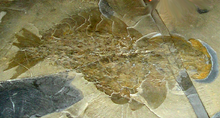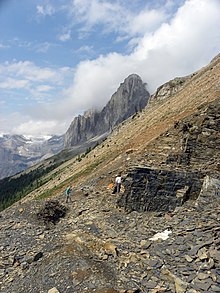Burgess Shale
| Burgess Shale | |
|---|---|
| Stratigraphic range: | |
 Marrella, the most abundant Burgess Shale organism. | |
| Type | Geological formation |
| Unit of | Stephen Formation |
| Thickness | Template:M to ft[1] |
| Lithology | |
| Primary | Shale |
| Location | |
| Coordinates | 51°26′N 116°28′W / 51.433°N 116.467°W |
| Region | Yoho National Park |
| Country | Canada |
| Type section | |
| Named for | Burgess Pass |
| Named by | Charles Doolittle Walcott, 1911 |
| Part of a series on |
| The Burgess Shale |
|---|
 |
The Burgess Shale Formation — located in the Canadian Rockies of British Columbia — is one of the world's most celebrated fossil fields,[2] and the best of its kind.[3] It is famous for the exceptional preservation of the soft parts of its fossils. It is 508 million years (Middle Cambrian) old,[4] one of the earliest soft-parts fossil beds.
The rock unit is a black shale, and crops out at a number of localities near the town of Field in the Yoho National Park.
History and significance

The Burgess Shale was discovered by palaeontologist Charles Walcott in 1909, towards the end of the season's fieldwork.[5] He returned in 1910 with his sons, establishing a quarry on the flanks of Fossil Ridge. The significance of soft-bodied preservation, and the range of organisms he recognised as new to science, led him to return to the quarry almost every year until 1924. At this point, aged 74, he had amassed over 65,000 specimens. Describing the fossils was a vast task, pursued by Walcott until his death in 1927.[5] Walcott, led by scientific opinion at the time, attempted to categorise all fossils into living taxa, and as a result, the fossils were regarded as little more than curiosities at the time. It was not until 1962 that a first-hand reinvestigation of the fossils was attempted, by Alberto Simonetta. This led scientists to recognise that Walcott had barely scratched the surface of information available in the Burgess Shale, and also made it clear that the organisms did not fit comfortably into modern groups.
Excavations were resumed at the Walcott Quarry by the Geological Survey of Canada under the persuasion of trilobite expert Harry Blackmore Whittington, and a new quarry, the Raymond, was established about 20 metres higher up Fossil Ridge.[5] Whittington, with the help of research students Derek Briggs and Simon Conway Morris of the University of Cambridge, began a thorough reassessment of the Burgess Shale, and revealed that the fauna represented were much more diverse and unusual than Walcott had recognized.[5] Indeed, many of the animals present had bizarre anatomical features and only the sketchiest resemblance to other known animals. Examples include Opabinia, with five eyes and a snout like a vacuum cleaner hose; Nectocaris, which resembles either a crustacean with fins or a vertebrate with a shell; and Hallucigenia, which was originally reconstructed upside down, walking on bilaterally symmetrical spines.
With Parks Canada and UNESCO recognising the significance of the Burgess Shale, collecting fossils became politically more difficult from the mid-1970s. Collections continued to be made by the Royal Ontario Museum. The curator of invertebrate palaeontology, Desmond Collins, identified a number of additional outcrops, stratigraphically both higher and lower than the original Walcott quarry.[5] These localities continue to yield new organisms faster than they can be studied.
Stephen Jay Gould's book Wonderful Life, published in 1989, brought the Burgess Shale fossils to the public's attention. Gould suggests that the extraordinary diversity of the fossils indicate that life forms at the time were much more diverse than those that survive today, and that many of the unique lineages were evolutionary experiments that became extinct. Gould's interpretation of the diversity of Cambrian fauna relied heavily on Simon Conway Morris' reinterpretation of Charles Walcott's original publications. However, Conway Morris strongly disagreed with Gould's conclusions, arguing that almost all the Cambrian fauna could be classified into modern day phyla.[6]
Geological setting

The fossiliferous deposits of the Burgess Shale correlate to the Stephen formation, a collection of slightly calcareous dark mudstones, about 508 million years old.[5] The beds were deposited at the base of a cliff about 160 m tall,[5] below the depth agitated by waves during storms.[7] This vertical cliff was composed of the calcareous reefs of the Cathedral Formation, which probably formed shortly before the deposition of the Burgess Shale.[5] The precise formation mechanism is not known for certain, but the most widely accepted hypothesis suggests that the edge of the Cathedral Formation reef became detached from the rest of the reef, slumping and being transported some distance — perhaps kilometers — away from the reef edge.[5] Later reactivation of faults at the base of the formation led to its disintegration from about 509 million years ago.[8] This would have left a steep cliff, the bottom of which would be protected, because the limestone of the Cathedral Formation is difficult to compress, from tectonic decompression. This protection explains why fossils preserved further from the Cathedral Formation are impossible to work with — tectonic squeezing of the beds has produced a vertical cleavage that fractures the rocks, so they split perpendicular to the fossils.[5] The Walcott quarry produced such spectacular fossils because it was so close to the Stephen Formation — indeed the quarry has now been excavated to the very edge of the Cambrian cliff.[5]
It was originally thought that the Burgess Shale was deposited in anoxic conditions, but mounting research shows that oxygen was continually present in the sediment.[9] The anoxic setting had been thought to not only protect the newly dead organisms from decay, but it also created chemical conditions allowing the preservation of the soft parts of the organisms. Further, it reduced the abundance of burrowing organisms — burrows and trackways are found in beds containing soft-bodied organisms, but they are rare and generally of limited vertical extent.[5] Brine seeps are an alternative hypothesis - see Burgess Shale type preservation for a more thorough discussion.
Stratigraphy

The Burgess Shale Formation comprises 10 members, the most famous being the Walcott Quarry Shale Member comprising the greater phyllopod bed.[7]
Taphonomy and diagenesis
Please expand this section[10][11][12][13][14][15]
There are many other comparable Cambrian lagerstätten; indeed such assemblages are far more common in the Cambrian than in any other period. This is mainly due to the limited extent of burrowing activity; as such bioturbation became more prevalent throughout the Cambrian, environments capable of preserving organisms' soft parts became much rarer.[5] (The pre-Cambrian fossil record of animals is sparse and ambiguous.)
Biota
The biota of the Burgess Shale appears to be typical of Middle Cambrian deposits.[5] Although the hard-part bearing organisms make up as little as 14% of the community,[5] these same organisms are found in similar proportions in other Cambrian localities. This means that there is no reason to assume that the organisms without hard parts are exceptional in any way; indeed, many appear in other lagerstätten of different age and locations.[5]
The biota consists of a range of organisms. Free-swimming (Template:Wict) organisms are relatively rare, with the majority of organisms being bottom dwelling (benthic) — either moving about (vagrant) or permanently attached to the sea floor (sessile).[5] About two-thirds of the Burgess Shale organisms lived by feeding on the organic content in the muddy sea floor, while almost a third filtered out fine particles from the water column. Under 10% of organisms were predators or scavengers, although since these organisms were larger, the biomass was split equally between each of the filter feeding, deposit feeding, predatory and scavenging organisms.[5]
See also
- Body form
- Invertebrate paleontology
- History of invertebrate paleozoology
- List of fossil sites (with link directory)
- List of notable fossils
References
- ^ Lexicon of Canadian Geological Units. "Burgess Shale". Retrieved 2009-02-06.
- ^ Gabbott, Sarah E. (2001). "Exceptional Preservation". Encyclopedia of Life Sciences. doi:10.1038/npg.els.0001622.
- ^ Attention: This template ({{cite doi}}) is deprecated. To cite the publication identified by doi:10.1038/460952a, please use {{cite journal}} (if it was published in a bona fide academic journal, otherwise {{cite report}} with
|doi=10.1038/460952ainstead. - ^ Butterfield, N.J. (2006). "Hooking some stem-group" worms": fossil lophotrochozoans in the Burgess Shale". Bioessays. 28 (12): 1161. doi:10.1002/bies.20507. PMID 17120226.
{{cite journal}}: Cite has empty unknown parameters:|map=and|map_caption=(help) - ^ a b c d e f g h i j k l m n o p q r Briggs, D. E. G.; Erwin, D. H.; Collier, F. J. (1995), Fossils of the Burgess Shale, Washington: Smithsonian Inst Press, ISBN 1-56098-659-X, OCLC 231793738
- ^ The Crucible of Creation: The Burgess Shale and the Rise of Animals , Simon Conway Morris
- ^ a b Gabbott, S.E.; Zalasiewicz, J.; Collins, D. (2008). "Sedimentation of the [[Phyllopod bed]] within the Cambrian Burgess Shale Formation of British Columbia". Journal of Geological Society. 165 (1): 307. doi:10.1144/0016-76492007-023.
{{cite journal}}: URL–wikilink conflict (help) - ^ Attention: This template ({{cite doi}}) is deprecated. To cite the publication identified by doi: 10.1016/j.palaeo.2009.02.012 , please use {{cite journal}} (if it was published in a bona fide academic journal, otherwise {{cite report}} with
|doi= 10.1016/j.palaeo.2009.02.012instead. - ^ Attention: This template ({{cite doi}}) is deprecated. To cite the publication identified by doi:10.1016/j.palaeo.2009.02.016, please use {{cite journal}} (if it was published in a bona fide academic journal, otherwise {{cite report}} with
|doi=10.1016/j.palaeo.2009.02.016instead. - ^ Butterfield, N.J. (1990). "Organic Preservation of Non-Mineralizing Organisms and the Taphonomy of the Burgess Shale". Paleobiology. 16 (3): 272–286. Retrieved 2008-06-22.
- ^ Butterfield, N.J. (2002). "Leanchoilia guts and the interpretation of three-dimensional structures in Burgess Shale-type fossils". Paleobiology. 28 (1): 155–171. doi:10.1666/0094-8373(2002)028<0155:LGATIO>2.0.CO;2.
- ^ Orr, Patrick J.; Briggs, Derek E. G.; Kearns, Stuart L. (1998). "Cambrian Burgess Shale Animals Replicated in Clay Minerals". Science. 281 (5380). AAAS: 1173. doi:10.1126/science.281.5380.1173. PMID 9712577. Retrieved 2008-06-22.
{{cite journal}}: CS1 maint: multiple names: authors list (link) - ^ CARON, JEAN-BERNARD; JACKSON, DONALD A. (2006). "Taphonomy Of The Greater Phyllopod Bed Community, Burgess Shale". PALAIOS. 21 (5). Society for Sedimentary Geology: 451–465. doi:10.2110/palo.2003.P05-070R.
{{cite journal}}: CS1 maint: multiple names: authors list (link) - ^ Gaines, R.R.; Kennedy, M.J.; Droser, M.L. (2005). "A new hypothesis for organic preservation of Burgess Shale taxa in the middle Cambrian Wheeler Formation, House Range, Utah". Palaeogeography, Palaeoclimatology, Palaeoecology. 220 (1–2). Elsevier: 193–205. doi:10.1016/j.palaeo.2004.07.034. Retrieved 2008-06-22.
{{cite journal}}: CS1 maint: multiple names: authors list (link) - ^ Butterfield, N.J.; Balthasar, U.W.E.; Wilson, L.A. (2007). "Fossil Diagenesis In The Burgess Shale". Palaeontology. 50 (3). Blackwell Synergy: 537–543. doi:10.1111/j.1475-4983.2007.00656.x. Retrieved 2008-06-22.
{{cite journal}}: CS1 maint: multiple names: authors list (link)
Further reading
- Gould, Stephen Jay & Conway Morris, Simon. Debating the significance of the Burgess Shale: "Simon Conway Morris and Stephen Jay Gould, "Showdown on the Burgess Shale," Natural History magazine, 107 (10): 48-55".
{{cite journal}}: Cite journal requires|journal=(help); External link in|title=
- Conway Morris, Simon. The Crucible of Creation: The Burgess Shale and the Rise of Animals, Oxford University Press, Oxford, 1998 (paperback 1999) ISBN 0-19-850197-8 (hbk), ISBN 0-19-286202-2 (pbk)
- Fortey, Richard. Trilobite: Eyewitness to Evolution, Flamingo, 2001. ISBN 0-00-655138-6
- Gould, V. Wonderful Life: Burgess Shale and the Nature of History, Vintage, 2000. ISBN 0-09-927345-4
- Briggs, D.E.G.; Erwin, Douglas H. & Collier, Frederick J. The Fossils of the Burgess Shale, Smithsonian, 1994. ISBN 1-56098-364-7
Sources
- The Burgess Shale Geoscience Foundation — official website
- The Burgess Shale — Evolution's Big Bang — Burke Museum of Natural History and Culture
- Burgess Shale Fossils
- The Cambrian Explosion — BBC Radio 4 broadcast, In Our Time, 17 February 2005, hosted by Melvyn Bragg (includes links to resource pages)
- Paleobiology Database The Burgess Shale (skeletonized fauna), Stephen Fm., British Columbia, Canada: St Davids, British Columbia
- Paleobiology Database Hanburia gloriosa, Phyllopod Bed, Burgess Shale, Canada — Whittington 1998: St Davids — Merioneth, British Columbia
- Smithsonian Museum
- Species index from the Smithsonian Institution
